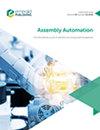Mixed-integer linear programming models for the type-II resource-constrained assembly line balancing problem
IF 1.7
4区 计算机科学
Q3 AUTOMATION & CONTROL SYSTEMS
引用次数: 1
Abstract
Purpose Resource-constrained assembly lines are widely found in industries that manufacture complex products. In such lines, tasks may require specific resources to be processed. Therefore, decisions on which tasks and resources will be assigned to each station must be made. When the number of available stations is fixed, the problem’s main goal becomes the minimisation of cycle time (type-II version). This paper aims to explore this variant of the problem that lacks investigation in the literature. Design/methodology/approach In this paper, the authors propose mixed-integer linear programming (MILP) models to minimise cycle time in resource-constrained assembly lines, given a limited number of stations and resources. Dedicated and alternative resource types for tasks are considered in different scenarios. Findings Besides, past modelling decisions and assumptions are questioned. The authors discuss how they were leading to suboptimal solutions and offer a rectification. Practical implications The proposed models and data set fulfil more practical concerns by taking into account characteristics found in real-world assembly lines. Originality/value The proposed MILP models are applied to an existing data set, results are compared against a constraint programming model, and new optimal solutions are obtained. Moreover, a data set extension is proposed due to the simplicity of the current one and instances up to 70 tasks are optimally solved.二类资源约束装配线平衡问题的混合整数线性规划模型
在制造复杂产品的行业中,资源受限的装配线广泛存在。在这些行中,任务可能需要处理特定的资源。因此,必须决定将哪些任务和资源分配给每个站点。当可用站点的数量固定时,问题的主要目标变成了最小化周期时间(类型ii版本)。本文旨在探讨文献中缺乏研究的这一问题的变体。设计/方法/方法在本文中,作者提出了混合整数线性规划(MILP)模型来最小化资源受限装配线的周期时间,给定有限数量的工位和资源。在不同的场景中,任务的专用和替代资源类型被考虑。此外,过去的建模决策和假设也受到了质疑。作者讨论了它们是如何导致次优解决方案的,并提供了纠正措施。实际意义通过考虑到现实世界装配线的特征,所提出的模型和数据集满足了更多的实际问题。将所提出的MILP模型应用于现有的数据集,将结果与约束规划模型进行比较,得到新的最优解。此外,由于当前数据集的简单性,提出了数据集扩展,最优解决了多达70个任务的实例。
本文章由计算机程序翻译,如有差异,请以英文原文为准。
求助全文
约1分钟内获得全文
求助全文
来源期刊

Assembly Automation
工程技术-工程:制造
CiteScore
4.30
自引率
14.30%
发文量
51
审稿时长
3.3 months
期刊介绍:
Assembly Automation publishes peer reviewed research articles, technology reviews and specially commissioned case studies. Each issue includes high quality content covering all aspects of assembly technology and automation, and reflecting the most interesting and strategically important research and development activities from around the world. Because of this, readers can stay at the very forefront of industry developments.
All research articles undergo rigorous double-blind peer review, and the journal’s policy of not publishing work that has only been tested in simulation means that only the very best and most practical research articles are included. This ensures that the material that is published has real relevance and value for commercial manufacturing and research organizations.
 求助内容:
求助内容: 应助结果提醒方式:
应助结果提醒方式:


